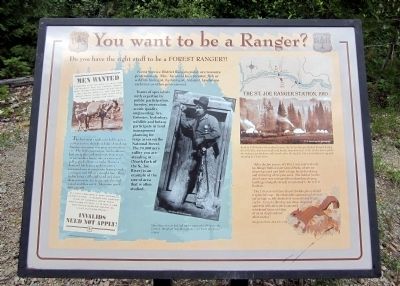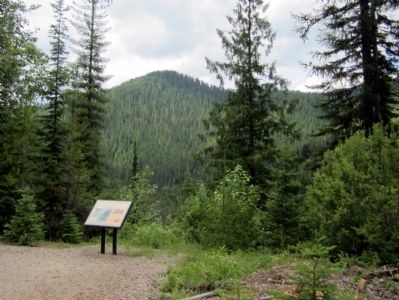Near Avery in Shoshone County, Idaho — The American West (Mountains)
You want to be a Ranger?
Do you have the right stuff to be a FOREST RANGER?!
Forest Service District Rangers today are resource professionals. She/he could be a forester, fish or wildlife biologist, hydrologist, botanist, landscape architect or other professional.
Teams of specialists with expertise in public participation, forestry, recreation, scenic quality, engineering, fire, hydrology, wildlife and botany participate in land management planning for large areas on the National Forest.
The 74,800 acre valley you are standing in (North Fork of the St. Joe River) is an example of the size of area that is often studied.
(sidebar)
The first ranger applicants had to pass a written test on their knowledge of ranching, forestry, surveying, mapping, construction, etc. The field examination, held outdoors, had the applicant demonstrate how to use an ax; saddle a horse, ride at a trot, and gallop; pack a horse or mule; “throw” a diamond hitch; pace and compute a measured area in acres; take bearings with a compass and follow a straight line. They had to bring a rifle and pistol and shoot them accurately at a target and, also cook a meal and then eat it. They were paid $60 a month.
(sidebar)
The St. Joe Ranger Station, 1910
Built in 1905 before the railroad came, the St. Joe Ranger Station burned during the 1910 fire, but was rebuilt and finally abandoned in 1918. In the above photo the station’s picket fence still stands after the big fire, but a tent station is up and running just days later.
“After the fire season of 1909, I was sent to the St. Joe Ranger Station near Grand Forks, where we cleared ground and built a large house for drying and extracting white pine seed. The lumber for the cone house was salvaged from abandoned camp buildings along the nearly constructed C.M.&P.S. Railway.
The 110-year old clear stand of white pine yielded a splendid crop. We robbed the squirrel caches and got as high as fifty bushels of cones from a single cache. I can, to this day, see those disgusted squirrels with their pitch smeared whiskered faces scolding at as we plundered their caches.” Ranger Joe Halm, Memoirs, 1944
Topics. This historical marker is listed in these topic lists: Disasters • Horticulture & Forestry • Railroads & Streetcars. A significant historical year for this entry is 1910.
Location. 47° 21.437′ N, 115° 42.852′ W. Marker is near Avery, Idaho, in Shoshone County. Marker can be reached from Moon Pass Road (Federal Road 456) 0.4 miles south of Loop Creek Road (Federal Road 326). Located along the Route of the Hiawatha Trail. Touch for map. Marker is in this post office area: Avery ID 83802, United States of America. Touch for directions.
Other nearby markers. At least 8 other markers are within 2 miles of this marker, measured as the crow flies. Laboring in Luxury (about 600 feet away, measured in a direct line); Railroad at WAR! (approx. 0.4 miles away); Rough Roads & Wrecks (approx. 0.6 miles away); Bumps on the Milwaukee Road (approx. ¾ mile away); Not So "Lucky" Swedes (approx. 1.1 miles away); The Route of the Hiawatha (approx. 1.1 miles away); Smooth as Silk (approx. 1.1 miles away); Busy Bogle Spur (approx. 1.1 miles away). Touch for a list and map of all markers in Avery.
More about this marker. On the left is a "USDA Forest Service Recruitemnt Poster, circa 1905"
In the center is a photo with the caption, "Standing over six feet tall and a muscular 300 pounds, Cyrus J. Bingham was the epitome of a 1905 era forest ranger. U.S. Forest Service photograph
On the upper right is a photo of "The St. Joe Ranger Station, 1910" U.S. Forest Service photograph
Also see . . . Route of the Hiawatha Rail Trail. (Submitted on August 5, 2011, by Bernard Fisher of Richmond, Virginia.)
Credits. This page was last revised on September 27, 2018. It was originally submitted on August 5, 2011, by Bernard Fisher of Richmond, Virginia. This page has been viewed 697 times since then and 11 times this year. Photos: 1, 2. submitted on August 5, 2011, by Bernard Fisher of Richmond, Virginia.

